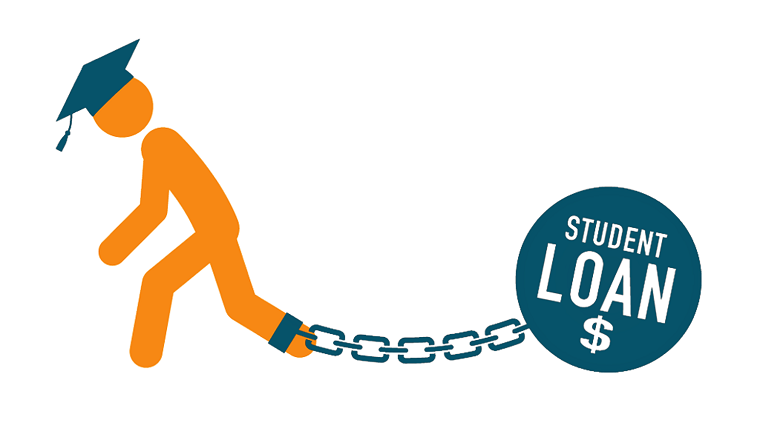How Does Student Loan Interest Work?

When taking out loans to cover the costs of college, most students aren’t looking ahead to the decades after graduation. They might know that student loan repayment is on the horizon, but borrowers often fail to consider the interest that can quickly accrue once their loan is disbursed.
How does student loan interest work, exactly? What’s involved in setting interest on student loans? What should a reasonable monthly payment look like?
These are crucial questions that all borrowers should ask to avoid taking on too much debt and to stay afloat when loan servicers start sending the bill. This guide will help you understand the basics of student loan interest, how to find good rates, and the best methods for developing a repayment plan.
In this guide:
- How does student loan interest work?
- How often is student loan interest compounded?
- How to calculate student loan interest
- When does student loan interest start accruing?
- How to pay off interest on student loans faster
- How can I lower my student loan interest rate?
How does student loan interest work?
As with a mortgage or any other type of loan, student loans are not free advances. Because of interest, the amount you borrow is typically less than what you will end up repaying over the life of the loan.
>> Read More: How Do Student Loans Work?
When you apply for a student loan from the U.S. Department of Education or a private financial institution, you will be quoted an interest rate. Depending on the information you provide in your application, this might or might not be your final rate.
The student loan interest rate your provider settles on is expressed as an annual percentage rate, or APR, which represents the actual yearly cost of funds over the term of a loan. Your rate could be fixed or variable.
- Fixed: A fixed APR will remain the same for the extent of your loan term.
- Variable: A variable APR fluctuates with changes to the market index to which it is tied. Variable interest rates are often lower than fixed rates at the outset, but might increase over the term of your loan.
You will be required to sign a promissory note before your provider disburses your loan. This note will indicate your official rate, and also outlines:
- Terms and conditions of your loan(s)
- Repayment plan choices
- Late charges and collection costs
- Explanations of defaulting, forbearance, consolidation, and any other pertinent information
Each day or month, the interest your loan generates will be tacked onto your total balance, which includes the principal (the initial borrowed amount) and interest accrued.
You must repay the interest prior to paying down the principal balance, so failing to make payments makes your debt more expensive over time.
How do interest rates differ between federal and private student loans?
Federal student loans typically carry lower interest rates than those from private companies.
>> Read More: Current Student Loan Interest Rates
You should almost always attempt to take out federal student loans prior to turning to private student loan lenders, and you should compare rates offered by multiple lenders before accepting a loan.
> Read More: Pros & Cons of Private Student Loans
How often is student loan interest compounded?
Compound interest is the addition of interest to the principal of a loan. Put simply, it is interest on the interest.
The promissory note for your student loans will also indicate how often your interest accrues as well as your compounding rate. Most student loans accrue interest daily and compound either daily or monthly.
Daily accrual means that lenders will divide the APR by 365 and apply that daily interest rate to your principal balance each day. Daily compounding would mean that your APR would also be applied to the amount of interest that accrued the day prior, in addition to the rest of your principal amount.
As such, compounded interest is constantly tacked onto your balance and incorporated into your next interest charge. So, the longer you take to address interest, the higher your compounded interest balance can climb.
How to calculate student loan interest
Loan providers use a simple formula to calculate daily compounding on student loan interest. All you have to do to determine your daily rate is multiply your principal by your APR and divide the product by 365.
Let’s assume you take out a $10,000 student loan with a 5% APR. Here’s what your interest would look like at year’s end, and then when compounded daily:
Annual Without Compounding
($10,000 x .05)/1 = $500 of interest accrued per year
With Daily Compounding
.05/365 = .000137 or .0137%
$10,000 x .000137 = $1.37 of additional interest accrued in the first day
$10,001.37 x .000137 = $1.37 of additional interest accrued in the second day, and so on
The same general rule applies to monthly compounding, except you’ll only pay interest on your interest once a month, giving you more time to pay down the debt before it’s capitalized.
At first, compounding interest doesn’t seem that significant. But over time, it can increase your costs significantly.
When does student loan interest start accruing?
You will start accruing interest at different times depending on the type of loan you take out.
In some cases, your interest begins accruing upon disbursement. This is always the case with private student loans and federal Direct Unsubsidized Loans. If you don’t make interest payments while in school, the interest will accrue throughout your years in college.
>> Read More: Federal Direct Loans
In the case of federal Direct Subsidized Loans, the federal government covers your accrued interest while you are in school and over a six-month grace period after you graduate. Once those six months are up, you are responsible for repaying the principal and the interest.
>> Read More: What is the Difference Between Subsidized and Unsubsidized Loans
To better tailor a plan of attack to your loan’s total amount and rates, have a look at LendEDU’s student loan repayment calculator. There you’ll discover how much you could save by paying off student loans early.
You don’t have to start paying student loan interest right away
Even for most unsubsidized loans, like those provided by private lenders, you won’t have to start paying interest immediately. Many private companies allow for a grace period, which can be excellent news for students who are unable to take on a job during college.
Under certain circumstances of financial hardship, such as a period of unemployment or significantly reduced income, borrowers can work with their lenders to enter deferment or forbearance and temporarily freeze or decrease their monthly payments.
This action helps to avoid defaulting when money gets tight.
During forbearance, lenders postpone principal payments on all types of federal student loans, but interest continues to accrue and will be tacked onto your principal once forbearance ends.
During deferment, lenders also postpone principal payments on all types of federal loans and negate interest that accrues on some. They will, however, expect you to pay interest on the following types of loans:
- Direct Unsubsidized
- Direct PLUS
- Federal Family Education Loan (FFEL) PLUS
- The unsubsidized portion of Direct Consolidation
- The unsubsidized portion of FFEL Consolidation
Regardless of these options for postponement, keep this in mind: Once you receive an unsubsidized loan, if you forgo payments through the six-month grace period after you leave school, you might already owe thousands more than you originally borrowed.
Should this be the case, it will take several payments before you begin paying down the principal.
How to pay off the interest on student loans faster
Prioritize your loans
The best method for quicker student loan repayment is to prioritize your loans by interest rate. Once you’ve established your payment schedule with automatic payments of at least the minimum required amount, allocate any remaining resources to the loan with the highest rate.
Make extra payments
We recommend making extra payments whenever possible—especially if your interest is compounded daily. Even just a second monthly payment helps to minimize the amount of time interest is allowed to accrue while you pay down the principal.
A great way to handle this is to make a payment every time you’re paid. Your first paycheck can cover the interest you’ve accrued in the previous month, and the second will eat away at the principal and limit the amount of interest that accrues in the subsequent month.
And if you’re paid every other week (with 26 paychecks in a year), you can get a full month ahead of schedule without affecting your monthly budget.
Refinance
Refinancing student loans is another great way to abate the pileup of interest. If you think you might qualify, apply for a loan with lower interest rates from a private company such as SoFi or check whether you can refinance through a state-run program.
>> Read More: SoFi Student Loan Refinancing Review
However, be aware that refinancing federal student loans with a private lender will forfeit any borrower protections you get with federal loans, such as eligibility for income-driven repayment or the potential for student loan forgiveness.
How can I lower my student loan interest rate?
Here are a few additional tips for lowering student loan interest rates:
- Refinancing: As mentioned above, refinancing through companies such as SoFi, Earnest, or a state-run program could significantly lower the interest rate for one or more of your loans.
- Loyalty discounts: Some banks offer borrowers slight reductions in private loan interest rates for existing customers.
- Autopay discounts: Many loan servicers reward borrowers for setting up automatic payment plans.
- Get a co-signer: Having a parent or significant other with an impressive credit history attached to your loan can give a private lender peace of mind that the money is in good hands and help you qualify for a lower rate.
By taking advantage of some of these options, you stand a greater chance of promptly paying down your student loan interest and then the principal.
Do your best to keep on schedule, get ahead when you can with additional monthly payments, and remain aware of what you owe.
If you need any more support in deciding how best to navigate your student loan situation, check out our in-depth guide for how to save money on student loans.
LendEDU also offers an arsenal of calculators and fact sheets to answer your questions. With these tools, you won’t ever feel hung out to dry while your student loan debt climbs.
Source: https://lendedu.com/blog/how-does-student-loan-interest-work/




